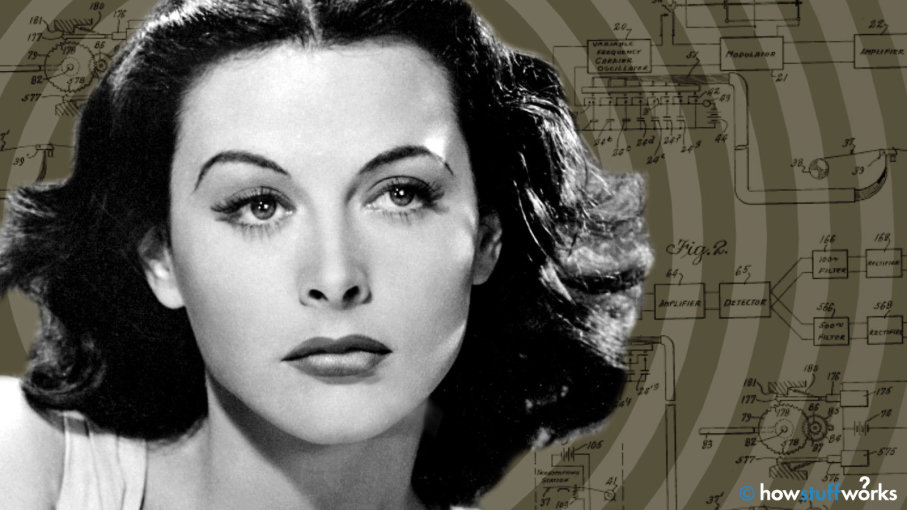How Hollywood Screen Siren Hedy Lamarr Helped Pioneer WiFi and GPS

“Any girl can be glamorous. All you have to do is stand still and look stupid.”
In two short sentences, famed actress Hedy Lamarr managed to call gender stereotypes, beauty ideals and Hollywood artifice into question, using a hint of humor to make meaningful social commentary. In a sense, this succinct soundbite offers more insight into Lamarr’s life and legacy than any headshot or publicity photo ever could, but understanding the context of the film star’s words provides even more meaning to the boundary-breaking successes and unexpected influence she continues to have, two decades after her death.
Born Hedwig Eva Maria Kiesler Nov. 9, 1914, the Austria native took an early interest in the performing arts, but seemed equally enchanted with science and engineering. “Hedy Lamarr grew up in a wealthy middle-class family in Vienna where she learned classical piano and enjoyed ballet, opera and chemistry,” says Alexandra Dean, director of the documentary, “Bombshell: The Hedy Lamarr Story,” via email. “She loved tinkering with her gadgets and took apart her music box and smashed a light bulb to see how it worked.”
By the time she was a teenager, Lamarr was turning heads for her stunning physical beauty — something that would both serve her and arguably hinder her success. “She became an actress because she thought it would be more fun than school, so she forged a note from her mother allowing her 10 hours away from classes and she went to her first audition,” Dean says. At 17 years old, Lamarr scored her first film role in a German project called “Geld auf der Strase.” She continued acting in European productions and in 1932, landed a controversial role in the scandalous-for-the-era film, “Exstase.”
“She was too beautiful for her own good,” Vincent Brook, author and UCLA media studies lecturer, says via email. “Her glamour queen, sex goddess persona kept her from being seen for the brilliant, complex person that she was.”
Lamarr wed Austrian munitions dealer, Fritz Mandl, in 1933, but the marriage didn’t last long. She later said of the union, “I knew very soon that I could never be an actress while I was his wife…He was the absolute monarch in his marriage…I was like a doll. I was like a thing, some object of art which had to be guarded — and imprisoned — having no mind, no life of its own.” During their marriage, Lamarr was often spotted on Mandl’s arm as he kept company with friends and business partners, many of whom had alleged ties to the Nazi party.
By 1937, Lamarr had had enough and fled her marriage, her former life and all ties to Austria. She headed to London, and soon signed a contract with Hollywood’s Metro-Goldwyn-Mayer studio under the name Hedy Lamarr. Her first American film, “Algiers,” kicked her career into high gear, and soon Lamarr was a household name.
The Heavenly Body, Hedy Lamarr
Hedy Lamarr starred in 1944’s “The Heavenly Body.”
WIKIMEDIA COMMONS
“The sexist double-standard was reversed for Lamarr in other ways,” Brook says. “Compared to German-accented male actors in Hollywood, who were relegated in the 1940s to supporting roles, mostly as Nazis, she and Marlene Dietrich, given their exotic/erotic allure, retained their marquee value.”
World War II and Frequency Hopping
In the early years of her newfound fame, Lamarr dated some of Hollywood’s most famous and infamous men, including Howard Hughes. The pilot and businessman reportedly took Lamarr along to tour airplane factories and asked for Lamarr’s input on aviation design and theory. But it wasn’t until 1942 that Lamarr’s innovative thinking inspired an unprecedented invention. In collaboration with composer George Antheil, Lamarr came up with an electronic device that minimized the jamming of radio signals.
“During World War II, Hedy’s mother was trapped in Vienna, and since she was Jewish, she was in great danger,” Dean says. “Hedy already lived in Hollywood and was helping her mother escape to America. She got as far as London but it was not safe to cross the Atlantic because every American ship was getting blown up by the Nazis. Hedy was terrified her mother would die in the London Blitz and so every night she worked on inventing a remote controlled torpedo so advanced it would be able to hunt down and blow up every Nazi submarine in the Atlantic thus securing safe passage to the U.S. To make sure the Nazis couldn’t hack the radio signal for her torpedo (and send it back to blow up the Allied ship that launched it), she created a ‘secret communication system’ that couldn’t be hacked.”
The “secret communications system,” utilized changing radio frequencies to prevent enemies from decoding messages. Multiple radio frequencies were used to broadcast a radio signal, which changed frequencies at split-second intervals in an apparently random manner. To anyone listening, it would just sound like noise. But the signal would be clear if both the sender and receiver hopped frequencies at the same time. (The patent was filed under Lamarr’s married name at the time Hedy Kiesler Markey.)



 Creators of mankind
Creators of mankind Description of “Tall white aliens”
Description of “Tall white aliens” Where they came from?
Where they came from? About hostile civilizations
About hostile civilizations The war for the Earth
The war for the Earth “Tall white aliens” about eternal life
“Tall white aliens” about eternal life Video: “Nordic aliens”
Video: “Nordic aliens” Aliens
Aliens Alien encounters
Alien encounters The aliens base
The aliens base UFO
UFO Technology UFO
Technology UFO Underground civilization
Underground civilization Ancient alien artifacts
Ancient alien artifacts Military and UFO
Military and UFO Mysteries and hypotheses
Mysteries and hypotheses Scientific facts
Scientific facts


















